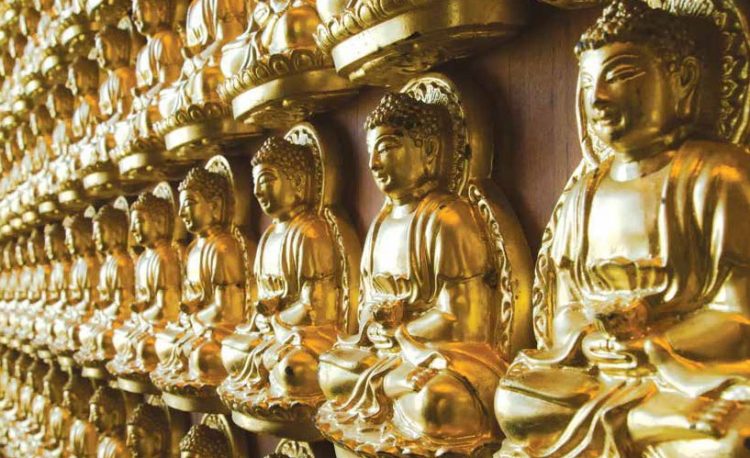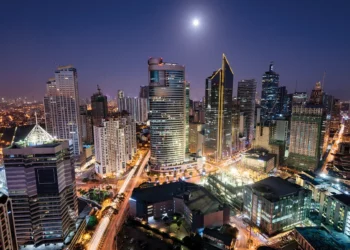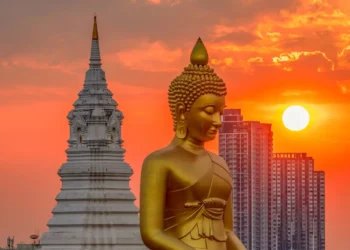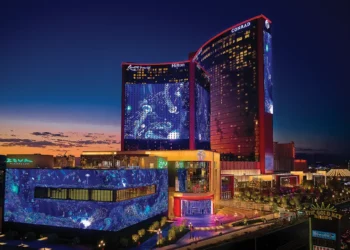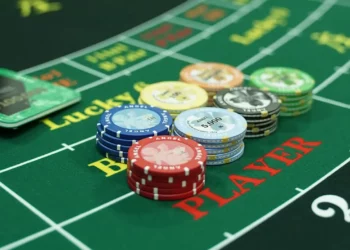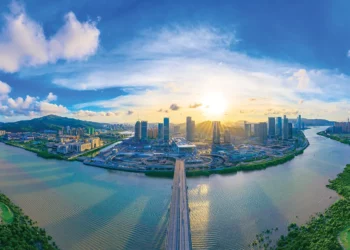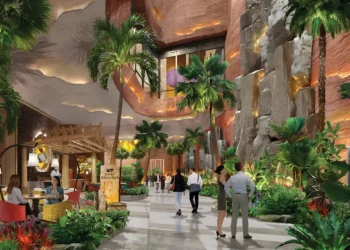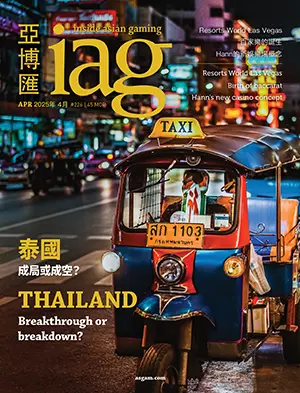In a ranking undertaken earlier this year of the 20 largest gaming companies by US dollar revenues, Global Betting & Gaming Consultants discovered that every company in the top 10 has a direct involvement in Asia either as an operator or investor.
The phenomenal success stories that are Macau and Singapore have set a pace for revenue growth in the larger Asia-Pacific region that PricewaterhouseCoopers believes will surpass the United States this year as the world’s largest. By 2015, the firm expects regional gaming revenues will hit US$79.3 billion, accounting for 43% of the global market.
What this foretells is a “geographic shift in revenue origination,” PwC says.
“This trend reflects the fact that demand in Asian countries currently far outstrips supply and that, for the next few years at least, operators and countries that offer further high-quality capacity in the region can be fairly certain that they will soon see it absorbed.”
Which, of course, speaks more or less directly to the profound influence of China on the region’s leisure and tourism landscape.
Rapid urbanization, rising disposable incomes and the relaxation of government restrictions on travel have transformed the Chinese population into the largest source of tourism revenue on Earth, a record $102 billion last year. International trips by Chinese citizens in 2012 exceeded 82 million. By 2015 they are expected to reach 100 million.
“This happened all in one generation,” as Wolfgang Arlt, director of the China Outbound Tourism Research Institute, has noted. “Many have parents who didn’t have shoes. Now they’re showing the world and themselves: ‘I’m strong. I can go spend US$5,000 for nothing, just my pleasure.’”
Yet, gambling is anything but exclusive to the Chinese, and PwC is not alone in recognizing that in Asia it remains vastly underserved.
“Definitely, the success of Macau has set off a chain reaction in what is happening in the region,” says Francis Lui, vice chairman of Galaxy Entertainment Group. “You see more countries now assessing the pros and cons of having gaming as a driving engine for bigger economic growth.”
The drivers, as you’d expect, are as varied as the region itself. At Entertainment City, the Philippines is taking the master-planned route. Taiwan is experimenting with something similar although on a much more limited scale. South Korea is dressing up the area around Incheon International Airport with tax breaks and other incentives. Even tiny Sri Lanka has entered the fray. And in Japan, a historically conservative political culture is shaking things up in Asia’s second-largest economy with the possibility that legalization will happen much sooner than anyone imagined.
Mr Lui has put it succinctly: “The region is going to have more casinos.”
CAMBODIA
The ASEAN Model
Cambodia’s growing appeal as a regional destination should continue to pay sweet dividends for the NagaWorld casino monopoly in Phnom Penh.
Visitation to the Southeast Asian nation increased 24% last year to 3.5 million, driven primarily by travelers from Vietnam, South Korea and China. Tourism receipts totaled US$2.21 billion in 2012 as average spend per capita, which has been on the rise for the better part of two decades, hit $663. The Ministry of Tourism is expecting 4 million visitors this year on the strength of forecasts calling for robust GDP growth across Indochina—7% annually through 2017, according to the International Monetary Fund—coupled with domestic infrastructure improvements, highlighted by a planned expansion of the international airport in Phnom Penh, and a broader reach into markets outside Southeast Asia, including more direct flight connections with mainland China. Actually, China is the country’s fastest-growing source of visitation (+35% YoY in 2012), and its contribution is expected to reach 500,000 by 2015 and 1 million by 2020.
NagaWorld, the principal asset of Hong Kong-listed NagaCorp, enjoys an exclusive license within a 200-kilometer radius of the capital. The property is coming off a banner 2012 and looking forward to the opening of Naga2, which broke ground in November. Naga2 will add 1,033 hotel rooms, 200-300 table games, 50 VIP gaming rooms, 500 EGMs, entertainment and MICE facilities, and an underground shopping mall—the stuff of “a truly integrated gaming and entertainment destination,” as company Chairman Timothy McNally puts it.
The property is already substantial by regional standards—660 hotel rooms, 1,700 electronic gaming machines and 170 live table games, 15 food & beverage outlets, a nightclub, a spa, 25,000 square meters of meeting space—and there are no statutory limits on gaming capacity. Revenues in 2012 were up 24.6% YoY to US$278.8. Pretax earnings were up 23% to $137.8 million for a sparkling 49% operating margin. Vietnamese players are the mainstay, accounting for an estimated 35-40% of main floor revenues. But VIP play, most of it Malaysian, is an increasingly important part of the mix, generating $95 million in revenue last year on a 17% increase in rolling chip volume. Five or so junkets are driving most of the volume, although the property has relationships with some 30 different operatives. Last year saw the opening of the company’s first sales offices in Ho Chi Minh City and Bangkok.
Gambling generates more than 90% of revenues, but performance from the nongaming side continues to improve. Room revenue increased 36%, food and beverage sales, 54%, entertainment and other revenues, 37%, a tribute to management’s success at up-selling the total offering to visitors with a bit more wallet.
The role of the Vietnamese in driving these higher-margin segments has been significant enough to merit its own 200- room hotel wing and a dedicated gaming area for bigger cash players. Saigon Palace, it’s called. It opened earlier this year with Vietnamese-speaking dealers and Vietnamese food and music.
Cambodia’s cheaper thrills are provided by 30 or so small casinos and slot parlors concentrated around the towns of Poipet and Pailin along the border with Thailand, where gambling is illegal, and in Bavet, bordering Vietnam, where casinos are off limits to locals. CIMB, an ASEAN-facing investment bank headquartered in Kuala Lumpur, estimates this frontier trade at 20- 30% of the total market, although no one knows for sure since it operates with little or no regulation.
Entertainment Gaming Asia, adistributor and lessor of EGMs in Cambodia (670 of them in NagaWorld) and the Philippines opened its first Dreamworldbranded casino in Pailin last May with 26 tables, two VIP rooms and 50 EGMs. Built for US$2.5 million it was immediately hailed by equity analysts Union Gaming Research Macau as the “category killer” of the borderlands. The company is slated this month to open a more elaborate slots-only casino in Poipet for $7.5 million.
EGA also has eyes for the province of Kampot on the southeast coast where the pickings have been less than lush. A fairly big casino there abruptly closed its doors in January: Hà Tiên Vegas, it was called, situated across the Mekong Delta from the picturesque beaches of the Vietnamese province of the same name. Not far away, in the Bokor Highlands about two hours south of Phnom Penh, Thansur Bokor Resort and Casino, where EGA also leases machines, is reported to be struggling in its first year.
JAPAN
No Time Like the Future
The word out of Japan is that Prime Minister Shinzo Abe’s government may include casino development in a new national economic growth plan to be drawn up next month.
English-language daily The Japan Times, citing unnamed but “informed” individuals, reports that Mr Abe may propose special zones for investment in privately operated resort complexes featuring hotels, casinos and other attractions. He told the Budget Committee of the National Diet’s House of Representatives in March that lifting the country’s longstanding prohibition on casinos is an idea with “merit”.
Advocates have been pushing gaming’s potential economic benefits for the better part of a decade with little by way of political traction to show for their efforts. However, this go-round they appear to have the requisite support at the top and have secured an influential former chief cabinet secretary as their leader, Hiroyuki Hosoda, a veteran of the ruling Liberal Democratic Party said to be a confidante of Mr Abe’s.
The news that Trade Minister Toshimitsu Motegi and Education Minister Hakubun Shimomura have been appointed to advise the pro-casino caucus in the House would also indicate that legislative momentumis building toward introduction of an authorizing bill, but not before elections in July to the House of Councillors, the Diet’s upper chamber, which is still controlled by the opposition Democratic Party of Japan and where a coalition led by the LDP hopes to seize a majority. The non-partisan caucus says it wants to submit a bill by the fall with a view to securing legalization within two years, according to a recent Reuters report.
“You need both sides of the equation before things really get moving. We want to make that happen this year,” said the caucus’s deputy leader, Takeshi Iwaya, another prominent LDP lawmaker who served in Mr Abe’s first government in 2006.
Given Japan’s sizable urban population and high propensity to gamble, the viability of casinos in the world’s third-largest economy has never been in doubt, and global names of the likes of Las Vegas Sands and Genting have expressed interest in investing a lot of money. The country has long hosted thriving racing and lottery industries, and a machine gaming sector centered on the pinball-like game pachinko is estimated to generate some US$200 billion in revenue a year. Investment brokers CLSA Asia-Pacific Markets estimate that one resort-scale casino in Tokyo and one in Osaka or another major city could be worth at least $10 billion a year, easily surpassing the $5.9 billion Singapore’s two resort casinos generated in 2012 and the $6.2 billion booked on the Las Vegas Strip last year. Tokyo Governor Naoki Inose has hinted at his support, and it is reported that Osaka’s popular pro-casino Mayor Toru Hashimoto, a founder of the rightist Japan Restoration Party, also wants to sponsor a casino bill.
That said, a multiplicity of divergent political interests together with a history of governmental instability have been major obstacles, especially when combined with the country’s inherent social conservatism. Advocates hope to finally overcome these with the backing of Mr Abe, who was returned to power in December and has been winning popular points with his aggressive approach to tackling thecountry’s chronic economic malaise.
If there is anything to the wisdom of stock markets, maybe this really is the time.
Pachinko manufacturing giant Sega Sammy Holdings has seen its share price rise more than 50% this year despite a big drop in profit for the 12 months ended 31st March and a subsequent lowering of its earnings forecast. Mizuho Securities, for one, told Reuters it likes Sega Sammy’s prospects along with those of Fuji Media Holdings, a broadcaster located in a section of Tokyo considered prime territory for casino development.
Sega Sammy, which is developing a casino in South Korea in partnership with that country’s Paradise Group, stated a desire as far back as 2007 to invest in casinos in Japan should the opportunity arise and last February purchased a resort in Miyazaki Prefecture. Two months after that acquisition was announced, company President Hajime Satomi reasserted the company’s intentions, saying, “Of course, [a casino] is what we have in mind.”
LAOS
Rewards and Their Risks
Tourism is Laos’ fastest-growing industry, and its importance prompted the government to authorize casino gaming as part of a massive special economic zone that was leased to Chinese developers in the province of Bokeo in the “Golden Triangle” frontier area bordered by Laos, Myanmar and Thailand.
The development company Dokngiewkham quickly opened a casino, the Kings Roman, and unveiled plans for the 10,000-square-hectare zone that include an airport, luxury hotels, an industrial complex, a bridge across the Mekong River and housing for 200,000 workers and their families, mostly Chinese.
In the process Laos found that it had largely relinquished sovereignty over the area, which evolved into a self-governing Chinese colony for all intents and purposes, a situation the authorities were apparently prepared to accept for the sake of the investment the small, landlocked nation of 6.5 million sorely needs. It was also a decision they came to regret when a second casino sprung up in Boten to the northwest across from China’s Yunnan province. The Royal Jinlun, as it was called, grew into a serious operation with 150 tables and 300 machine games and a clutch of supporting hotels where only Chinese was spoken, only yuan was accepted as payment and where even the prostitutes advertised on business cards printed in Mandarin. Crime became a serious issue, getting so bad that border security became an issue. When word got out that the owner was looking to sell to another Chinese investor, the government was compelled to act. The casino was shut down last year and a report in the Englishlanguage daily Vientiane Times said the SEZs would no longer be permitted gambling facilities “after finding such operations created serious problems for Laos.”
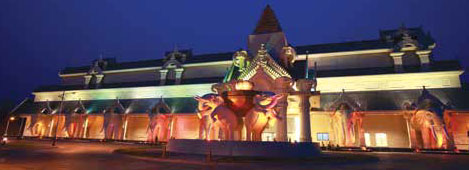
Savan Vegas Hotel & Entertainment Complex
The ruling did not affect the Kings Roman complex, which was adding buildings at that point, but it does speak to the risks Laos still poses for foreign capital more than 30 years after Pathet Lao guerrillas deposed the king and established socialist rule.
A Macau-based real estate consortium known as Sanum Investment Limited has learned this to its dismay after a court in Vientiane at the end of last year ordered the seizure of its Thanaleng Slot Club in Vientiane over a tax dispute. The venue is located on the main bridge from Thailand and books a hefty US$3 million in profits a month, and Sanum says the seizure was engineered by its minority partner, a politically connected Laotian company, to gain control of the club.
Sanum also operates a second slot hall on the Thai border and one on the Vietnam side, and the company fears that its Savan Vegas Hotel & Entertainment Complex downriver in Savannakhét, representing the bulk of its $400 million investment in the country, is also in the crosshairs. Sanum has a 50-year monopoly in Savannakhét and two other provinces which it believes the government would now like to bid out. Perhaps with that in mind the company filed a suit with the World Bank last fall to try to save Thanaleng. This was probably a bad idea because Savan Vegas is a prize worth taking: a 182-room hotel in Laos’ second largest city, featuring a pool and spa, several restaurants and a 5,000-square-meter casino with 500 slots and ETGs, 78 table games and a sports book. Savan is hoping the bank’s International Center for the Settlement of Investment Disputes can persuade the government that taking the club in the manner it did could violate international financial compacts to which Laos is a signatory.
“They want to be a member of the World Trade Organisation. They want to be a member in good standing of the international legal community. It will not happen until they can enforce the rule of law at home,” Sanum President Jody Jordahl said. “The treatment we have received shows they simply cannot be trusted.”
Authoritarian and famously corrupt as it may be, the Lao People’s Democratic Republic is not unaware of the benefits of commerce properly regulated. After years of being closed to the outside world, the country is now visa-free to all ASEAN nationals and to Koreans, Filipinos, Japanese, Russians and Swiss. Tourism is responsible for one in 10 jobs. Foreign visitation was up 22% last year to 3.3 million and up 14% the year before, when it generated an estimated US$679 million in revenue.
The country’s second-largest casino is flourishing in the 215-room Dansavanh Nam Ngum Resort about 70 kilometers outside Vientiane. The 14,800-hectare property is on a lake surrounded by a nature reserve, and boating and golf figure prominently in its offering. The casino contains 150 machine games and 85 live tables, including poker, and features a VIP club and five private rooms for big players.
MALAYSIA
Hall of the Mountain King
The victory of Malaysia’s pro-business ruling coalition in bitterly contested parliamentary elections earlier this month was good news for Genting Group and its sprawling mountaintop resort city north of Kuala Lumpur.
The balloting, which drew a record 80% of registered voters in this country of 29 million, was only the second since the political alliance known as Barisan Nasional took power 56 years ago, and the ultimate outcome was a little uncertain as of this writing as the opposition Pakatan Rakyat, led by former Finance Minister Anwar Ibrahim, refused to concede defeat, accusing the government and its hand-picked Election Commission of widespread fraud.
Mr Ibrahim is said to be popular among ethnic Chinese and Indians frustrated with Barisan’s pandering to the Malaysian majority, and it appears he’s gained support as well among increasing numbers of Malays who’ve grown tired of a regime perceived as irredeemably corrupt from too many years in power.
Prime Minister Najib Razak’s supporters, on the other hand, are alarmed by Pakatan Rakyat’s dependence on Islamic religious parties. They contend that Barisan has delivered political stability, robust economic growth and social reforms.
Whether or not a win by Mr Ibrahim would have extended the reach of Sharia law beyond domestic and religious matters involving Muslims, as Barisan warned, financial markets certainly were relieved that he didn’t. The ringgit jumped almost 2% with Mr Razak’s victory, one of its best performances ever, and the Bursa Malaysia’s KLCI Index hit record highs.
Genting Group’s resort arm, Genting Malaysia, which trades on the Bursa’s Main Market, kept its own counsel on the results, but it has made no secret of its bullishness on Malaysia’s prospects and its US$4 billion-plus worth of hotel and gaming assets there. Despite “regional competitive pressures” and a “cautious” outlook on gaming’s prospects generally, “Growth in regional tourism and domestic private consumption augurs well,” the company has stated.
Its Resorts World Genting flagship in Genting Highlands about an hour from the capital city, together with a pair of resort hotels in Langkawi on the Andaman Sea in the northwest and in Kijal on the South China Sea coast, account for more than 60% of the company’s global revenues and 90% of EBITDA. Genting Highlands—a complex of 8,000 rooms and suites in five hotels, theme parks and other family-oriented attractions, more than 100 food outlets, shops, an 18-hole golf course and MICE space—generated RM2.04 billion in EBITDA last year (US$688.2 million) on RM5.48 billion ($1.85 billion) in revenue.
It recorded more than 20 million visitors in 2011, primarily Malaysians, followed by Singaporeans and Indonesians and lesser numbers of Thais, Vietnamese, Chinese and Indians. More than 70% of visitors are day-trippers, an indication that Casino de Genting, the resort’s collection of themed gambling venues containing 3,000 slot machines and electronic table games and 500 live tables across 200,000 square feet, is a big draw, if not the biggest.
It helps, too, to have the national gambling monopoly, a happy circumstance that is allowing the company to beef up efforts to market itself as more than the low-rollers paradise it is perceived to be and to spend more aggressively to attract high-limit players from the wider region. In 2011, the company purchased two aircraft for this purpose.
THE PHILIPPINES
What Can Go Right
At about US$2 billion in annual revenues currently, the Philippines is well on the way to securing its position as Asia’s third-largest casino market, and the next five years or so could see it vying with Singapore for second place as resort development at the government-owned Entertainment City complex in Manila reaches critical mass.
This isn’t about bragging rights but about economic development and jobs for a nation that needs them badly. Tourism accounts for about 10% of employment in a country where 55% of the economy relies on services and the jobless rate is the highest in Southeast Asia. The goal is 10 million tourist arrivals by 2016, or about double last year’s figure. It could mean more than 3.5 million jobs, according to official projections.
The vision began to take shape in March with the opening of Entertainment City’s first megaresort, Solaire. Its US$750 million first phase has created 4,500 jobs at a gorgeous facility that includes 1,200 electronic gaming machines and 295 table games, 488 rooms and suites and an array of fine dining and casual restaurants.
But Solaire wasn’t open more than a month before an obstacle arose in the form of a ruling by the Bureau of Internal Revenue that casino licensees, including the government-owned operator, PAGCOR, and their supporting junkets must pay the country’s 30% corporate income tax. The ruling has everyone seriously rethinking their profit projections. Predictably, share prices have tumbled.
The big question, of course, is whether it will hinder the progress at Entertainment City, where Solaire is in the throes of a $400 million expansion slated for completion in the second half of 2014—with 300 suites, a theater, a spa and pool, retail and an expansive outdoor promenade—and Belle Grande Manila Bay, managed by Macau casino giant Melco Crown Entetainment, is scheduled to open next summer with 1,000 hotel rooms and suites and 1,900 EGMs and 350 table games together with what promises to be a vibrant assortment of nongaming attractions.
Two more integrated resorts have been licensed for Entertainment City with openings slated for further down the road. Resorts World Bayshore is backed by Travellers International Hotel Group, the joint venture between Genting Hong Kong and the Philippines’ Alliance Global Group that has already tasted success in the market as the developers of Resorts World Manila just a few miles away at Ninoy Aquino International Airport. Bayshore is looking to open in 2016 with more than 2,000 EGMs and 360 table games and 1,440 rooms and suites. Lastly there’s the tentatively titled Manila Bay Resort, a joint venture led by Japanese machine gaming tycoon Kazuo Okada and Robinsons Land, a major Philippine developer of hotels and shopping malls. At a projected cost of $2 billion, its plans call for an oceanarium, a sports arena and a giant Ferris wheel. The casino is to open in 2016 or shortly thereafter with 3,000 EGMs and 500 table games and a collection of hotels featuring 2,000 rooms and suites.
All this has been predicated on friendly gaming revenue tax rates of 17% on VIP and an effective 27% on mass play, higher than Singapore’s blended 16% but substantially lower than Macau’s 40%.
The phased opening of Resorts World Manila in 2009 and 2010 had a decisive effect on perceptions about the Philippines. As the property ramped up to its current 1,800 slots and 300 tables, as its supporting hotels opened and its retail, cinemas and other amenities came on line, gaming revenue in what had been a static market soared by more than 40%. It showed there was significant domestic demand eager to trade up to a better experience, and in the view of some analysts, the scale of that demand sets the Philippines apart.
“The Philippine population of 97 million is almost three times that of Singapore, Malaysia and Macau combined, presenting sizeable onshore potential for the higher-margin mass segment,” investment bank Credit Suisse notes.
Morgan Stanley has forecast 35% annual revenue growth through 2015 to $3 billion, which would have been unthinkable even five years ago when the market consisted of 13 or so smallish casnos and a couple dozen slot clubs operated by PAGCOR (Philippines Amusement and Gaming Corporation) with contributions from two private licensees, Panama-based Thurnderbird Resorts and Macau’s Jimei Group, which operate three casinos between them.
CLSA Asia-Pacific Markets believes the market has an outside shot at $6 billion.
“We believe the market is well-placed to exceed the current size of the Singapore market within the next six years,” says Credit Suisse.
Driving this, of course, will be the new supply coming on line at Entertainment City. So a lot is riding on a happy resolution of the tax issue. Government, PAGCOR and the various licensees are discussing possibly waiving the “franchise tax” embedded in the existing gaming taxes, which would reduce them both by 5%. Another way might be to address the ruling at its source. This would involve restoring PAGCOR’s tax-exempt status as a government-controlled corporation, which was revoked back in 2005.
“Overall, the situation remains fluid,” as one Philippines-based analyst told Gambling Compliance, an industry news site.
Alliance Global struck a positive tone in a statement saying, “We are optimistic that the government and the industry will come out with a common understanding supportive of the growth and success of the business.”
SINGAPORE
The Challenges to Growth
Resorts World Sentosa ended 2012 on a relative high note, given the challenging year that it was. Casino revenue was up 19% sequentially in the fourth quarter on a substantial pickup in VIP play (+56%), compared with Q1 2011. The top line, however, was down 3% and down 12% for all of 2012, hobbled in no small part by poor luck against those same VIPs.
Rolling chip volume continued strong into the first three months of 2013, up 38%, but revenue growth again was plagued by low hold (2.1% as opposed to the average at baccarat of 3% or thereabouts.)
Marina Bay Sands likewise had a terrific first quarter in terms of VIP volume, its best three months ever, in fact, but relatively weak hold of 2.51% (compared with 3.58% in Q1 2012) drove EBITDA down 16% on an 8.7% decline in revenue.
The impact on Sentosa was similarly profound. Union Gaming Research Macau estimates the property’s bad luck cost it S$150 million in EBITDA, which was down 32% from the fourth quarter and 34% year on year.

Resort World Sentosa
This is hardly coincidence, of course, VIP play being inherently risky, and Singapore’s risk factor being magnified in the absence of a junket industry like Macau’s to bring in the players and handle credit and collection. And the fewer the players the greater the risks. Yet the city-state’s gaming watchdog, the Casino Regulatory Authority, is famously wary of junkets and their reputed links to Chinese organized crime. The CRA to date has licensed only three “international marketing agents,” as they’re known locally, all employed by Resorts World Sentosa, where their percentage contribution to VIP volume is in the low single digits.
The irony is that about half the rolling chip volume at both properties consists of play out of China, which explains Las Vegas Sands’ characterization of Singapore as the “most challenging credit market”.
The US$150.5 million the company set aside in 2011 for doubtful accounts was “primarily due,” it said, to its Marina Bay Sands subsidiary, whose provision alone totaled $65.6 million. Last year, the provision for MBS was raised by more than $57 million, three times the increase allotted the company’s five Macau casinos.
At Resorts World Sentosa last year the impairment charge taken on “trade receivables” (the line item covering unpaid markers among other obligations) was up 18% to S$143 million. Another $1.1 million was written off as net bad debt, a 10% increase over the year before. In the first quarter, the charge taken on receivables was up 24% to $45.2 million. It was the second-biggest expense after administrative costs.
Managing risk is not an issue on the high-margin mass-market side, but both resorts are having to work harder three years into their existence to grow this lucrative segment, specifically to expand the visitor base to include more higher-limit cash players, the region’s prized “premium mass”. The local population is “essentially maxed out,” in the view of Union Gaming analyst Grant Govertsen, and the same largely goes for the pool of “high value” Malaysians and Indonesians, “likewise quite well-penetrated,” he says. A recent J.P. Morgan report echoes this assessment, citing “looming concerns” over “rising costs, falling margins and stagnant industry mass market”.
Fortunately, both are well-endowed with high-margin non-gaming attractions that generate about 20% of their total revenue. The hotel at Marina Bay Sands, the largest in Singapore, stood at 98.5% occupancy in the first quarter at an average daily rate of S$465. Resorts World Sentosa’s 1,500 rooms were 92% occupied at an ADR of $404.
In a review of operations at Resorts World Sentosa published earlier this year, Mr Govertsen warned of “persistently low mass-market growth” in 2013, submitting a forecast in the 4% range for tables and slots, reflecting where both properties stood at the end of the first quarter. (Mass table drop at MBS was up 2.4% year on year, slot handle was largely flat at +1.6%.)
Growing the pool of VIPs in a bid to smooth out volatility will likely see both market deeper into China, and Union Gaming, taking the VIP rebound in Macau as a bellwether, expects rolling chip play “to grow nicely” through the balance of 2013 but at a considerably lower volume than was seen in the first quarter, reflecting, among other things, a less aggressive approach to extending credit.
SOUTH KOREA
The Incheon Salient
More than 900,000 Chinese patronized South Korea’s foreigners-only casinos last year, a market comprised of 16 properties and worth in excess of KRW1.25 trillion in revenues (US$1.13 billion).
South Korea is capturing about 5% of China’s overseas tourism currently and expects that to grow to 10% by 2020, which would be around 10 million consumers. Gaming is cranking along nicely at annual growth rates in the low double digits on the strength of visitation from the PRC that has grown an average of 24% a year since 2009, very much in line with government’s vision of the country’s potential as a hub of the Asian travel and leisure boom.
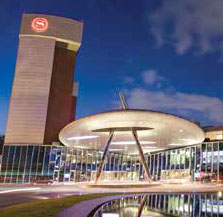
Sheraton Grande Walkerhill in Seoul
Paradise Group, which together with government-owned Grand Korea Leisure controls about 90% of the foreigners-only market, expects 4 million Chinese to be visiting Korean casinos by 2020 and is excited that it’s been chosen by the government to develop a US$600 million foreigners-only venue on Yeongjong Island in the Incheon Free Economic Zone in the northwest of the country about 50 kilometers from Seoul. What the company and its partner, Japanese pachinko giant Sega-Sammy, have in mind for the first new casino to be licensed in South Korea in years will be five times bigger than Paradise’s flagship at the Sheraton Grande Walkerhill in Seoul. Plans call for a phased opening beginning in 2016 with 450 table games at full build-out— twice as many as Paradise operates now in all five of its casinos—and with non-gaming attractions that include two five-star hotels, a convention center, retail and an indoor theme park.
The Incheon FEZ is one of six the government has launched to encourage domestic and foreign investors to think about Korea in a big way with substantial tax breaks, subsidies and other incentives. The gaming industry sees Incheon’s as the most promising because it’s home to the country’s principal airport and it’s the closest to China, about two hours by air from Beijing and an hour and a half or so from Shanghai. The largest operator in the United States, Las Vegas-based Caesars Entertainment, has its sights on Yeongjong and is seeking permission to develop a resort casino there in partnership with the Lippo Group, a conglomerate headquartered in Indonesia and listed in Hong Kong with holdings in retail, media, real estate, banking, natural resources, IT and health care. Tokyo-based Universal Entertainment, another major pachinko name and parent company of slot-maker Aruze, is reported to be in talks with Korea’s Shinsegae department store empire about a possible tie-up on Yeongjong. Much has been written also about a longer-range development targeted for the Incheon FEZ called EIGHTCITY. Backers reportedly include Korea Airlines, Daewoo and luxury hotel group Kempinski and plans call for a EuroVegas-size cluster of hotels and other attractions. At least one casino figures in the plan, but there has been no word on whether a request has been filed with the government.
Actually, it isn’t known whether the government intends to license gaming at any of these projects aside from the Paradise joint venture.
Last September, in the heat of the national elections, the administration of soon-to-be defeated President Lee Myung- bak lowered the up-front investment required of foreign entities interested in FEZ casinos from $300 million to $50 million and eased certain requirements on leverage and profitability. It was, in all, a modest reformation. But then, Korea has always been cautious in its approach to gaming expansion, and the new administration of President Park Geun-hye, which took office in February, isn’t sure it’s comfortable with even these alterations, and they’re said to be under review.
Likewise, the government is anxious to quell speculation that the domestic market will be allowed to expand beyond Kangwon Land, the publicly owned casino that was summoned into existence a decade ago in the remote northeastern highlands to provide a lift for a down-at-the-heels former coal mining region. Though operated as a non-profit, Kangwon Land has proven so successful that it’s become something of a political headache. Despite its distance from Seoul (three to four hours by express bus) and limits on visitation (15 days per month) and daily wagers ($275), the casino is pulling in 10,000 customers a day, far more than it has actual room for, and the annual revenues from its 960 slots and 130 or so tables have tended to exceed those of all the tourist casinos combined.
Down at the other end of the country on the self-governing island of Jeju in the Korea Strait, Malaysia’s Berjaya Group would love to include a casino for Koreans as part of its plans for a massive mixed-use residential, resort and health care complex. Berjaya, one of Asia’s largest companies whose holdings include land-based and online betting and lottery operations, is prepared to inject more money into Korean tourism than any foreign developer ever, about US$2.5 billion, and things could be in play on Jeju given the island’s status as the country’s only “special autonomous province,” which affords it a great deal of independence from the central government in areas like foreign direct investment.
Jeju used to be a popular destination for Japanese tourists, and it was an important stop for the Taiwanese before it became possible to fly direct from the ROC into mainland China. Japan’s gamblers have since migrated to the Philippines and to Grand Korea Leisure’s market-leading Seven Luck casinos in Seoul and Busan, and Jeju’s eight smallish venues, which include two Paradise casinos, have been left with not much of a growth story to tell.
In light of which, it’s a wonder how the island found its way onto the radar screen of the likes of Berjaya. The answer to that is China. The number of visitors from the PRC has grown from about 90,000 a decade ago to more than 1 million. Jeju has appeared on a survey by China’s Global Times as one of the country’s three favorite resort islands along with Hawaii and the Maldives. Last year, China’s Travel Weekly named it its top honeymoon destination. In 2012, Jeju was selected for the first overseas investment by Greenland Group, Shanghai’s largest property developer. Last month, Landing Investment Group, a real estate giant based in China’s Anhui province, signed an agreement to develop resort facilities on Jeju to support an expansive “Myths and History” theme park which the local government is hot for. Another Malaysian entity, EMG Group, also is planning a large resort investment.
SRI LANKA
A New Player
James Packer has acquired land in the Sri Lankan capital of Colombo for what is reported to be a US$350 million casino, and the island suddenly is on the industry’s radar.
It’s an interesting time for Sri Lanka, which is actively seeking developers to take its tourism industry to the next level and in the process grow the larger economy. The casino market today consists of nine or so small venues serving the tourist trade in and around the capital, but the government is making tax breaks available and other benefits to attract investment on a resort scale, investment like Packer’s, and some of gaming’s other big names have been taking a look.
Much has changed since the defeat in 2009 of a protracted armed uprising by the Hindu Tamil minority in the north of the island. By 2010, tourism receipts tripled to more than US$1 billion, according to a World Bank report, and the Sinhalese- Buddhist-dominated political leadership has wasted no time in directing attention to what is clearly a growth industry. In 2010, legislation was passed granting formal recognition to Colombo’s casinos, which up to that time had been referred to rather euphemistically as “recreation clubs” and were restricted (as they still are) to foreign passport holders. In 2011, India’s Delta Corp., Goa’s largest casino operator and owner of two Colombo venues, bought land in the capital for which it has been looking for partners to develop a resort-scale casino and supporting hotel.
Delta has in the past been in talks with MGM Resorts International and Caesars Entertainment about possible tie-ups in India, only the Indian government doesn’t allow foreign direct investment in gaming, an obstacle that finds Sri Lanka in a position of increasing importance as a gateway to the subcontinent’s increasingly affluent and leisure-hungry millions.
This year, the Sri Lanka Tourism Promotion Board is targeting India, China, the Middle East, Russia, South Korea and Japan with a $6 million marketing blitz showcasing the island’s considerable natural and historical attractions and the fact that these are accessible from just about anywhere in Asia, thanks to an international airport and an international airline, Sri Lankan, that flies to 68 destinations in 33 countries.
The government has its sights on 2.5 million tourist arrivals by 2016 and US$2 billion in related receipts. This should get a boost from a recent agreement reached with India to start running ferries again across the Gulf of Mannar. The service had been halted for years by the Tamil insurgency.
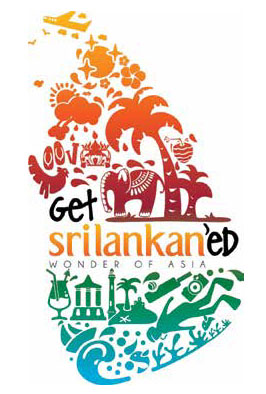
TAIWAN
Between China and China
Speaking at a press conference in Taipei last July, two days after the residents of Taiwan’s Matsu islands voted narrowly to approve casino gambling, Weidner Resorts boss William Weidner recognized the need to respond to concerns about whether the tiny, undeveloped archipelago hugging China’s Fujian coast can support a 21st century destination resort.
“I don’t see any problems that cannot be solved by modern technology,” he said.
Earlier this year, Weidner unveiled a dramatically expanded vision for the island chain: a veritable resort city to open in phases, consisting of clusters of high-rise hotels and providing 70,000 direct jobs. He says it will attract 5 million to 7 million visitors a year for starters, and he says he has commitments from a consortium of banking giants for around US$2.5 billion, a substantial portion of which is earmarked for bringing Matsu’s primitive infrastructure up to snuff. This will include expanding the small airport on the island of Beigan, constructing a ferry harbor and a bridge linking Beigan with Nangan, the other major island, and developing electrical generation and water treatment facilities.
He has also reached across the Taiwan Strait, apparently with some success, to sell officials in Fujian with its 37 million inhabitants on the wisdom of joining forces. In December, Weidner Resorts signed a preliminary agreement with Hong Kong ferry operator Chu Kong Passenger Transport for service between Fujian’s capital of Fuzhou and Matsu. Weidner also has proposed development of a supporting tourist hotel near Fuzhou, whose 4.4 million urban residents (together with the 5 million of the port city of Xiamen farther south) are considered key to the success of whatever ultimately gets built on Matsu.
Fuzhou officials like the hotel idea, according to Weidner, as does Taiwan’s pro-business Minister of Transportation and Communications Yeh Kuang Shih, whose department has recently drafted a preliminary regulatory framework for gaming on Matsu for consideration by the Legislative Yuan, the national parliament. The legislation would impose an effective 14% tax on gaming revenue which includes a 7% “franchise fee” for the first 15 years of operation, increasing to 8% through year 25 and 9% thereafter, and a local government tax capped at 7%. The minimum age for entering a casino would be set at 20, and a number of Singapore-style safeguards are proposed, such as banning recipients of government allowances and individuals who have been declared bankrupt or have bad credit records. The bill would also allow family members, close relatives or partners to request exclusion orders on relatives.
At a press conference following the release of the legislation last month, Mr Yeh said he doesn’t envision a resort casino on the scale Weidner proposes to open on Matsu before 2019.
Significantly, he said also that the government is not considering allowing casinos on Taiwan proper.
These are still very choppy political waters. Relations between the PRC and the Republic of China have thawed considerably over the last decade, but China still considers Taiwan a renegade province, and Fujian’s Lianjiang County actually claims the archipelago of Matsu as its territory. On Taipei’s side, the idea of entrusting a budding tourism economy to the effective control of travel policies dictated in Beijing is an issue the government will continue to consider very carefully.
Reports in the meantime are that Caesars Entertainment has sent an executive to Kinmen, a Taiwanese island group in the Taiwan Strait but farther down the coast. Kinmen also has hosted Liu Yung Hsiang, president of Taiwan construction giant Howarm, who visited recently in the company of junketeer and casino operator Jack Lam, whose Macau-based Jimei Group does business throughout East and Southeast Asia.
Half a century ago, Kinmen and Xiamen were lobbing artillery shells at one another. Today, a huge sign in gold letters against a red background stands above Xiamen’s western shore facing Kinmen: “Peaceful Reunification. One Country, Two Systems,” it says.
VIETNAM
Getting to Ho Tram
The Ho Tram Strip may be Vietnam’s biggest bet yet on destination gambling as an economic development tool, but it is far from the only one.
The country is home to five legal casinos containing in total around 500 electronic gaming machines and upwards of 75 table games. They’re all located in tourist hotels, some of which, like the Crowne International at Da Nang Beach and the Do Son and the Royal Hotel and Villas on picturesque Halong Bay, are marketed to an international clientele and are quite luxurious.
The border with China has proven another lucrative bet. There is a fairly new casino in Mong Cái in Quang Ninh province in the northeast, and one of the largest slot floors in the country is in a casino controlled by relatives of Genting Group Chairman Lim Kok Thay in the Lao Cai International Hotel in the northwestern mountains adjoining China’s Yunnan province, about 300 kilometers above Hanoi. Seventy percent of the people of Lao Cai live in poverty, most of them ethnic minorities, but the province draws more than a quarter-million day-tripping Chinese a year, and that has enabled some of the more enterprising citizens of the provincial capital of Lao Cai and the nearby resort town of Sa Pa to grow rich off the cross-border traffic in goods, gambling and exotic Hmong and Dao women.
There are another 740 or so EGMs in more than 20 clubs nationwide and a popular public lottery whose sales account for about 2.5% of gross domestic product. Pari-mutuel betting has been around for decades at a horse track in Ho Chi Minh City and more recently at a greyhound track about 120 kilometers to the east in the coastal province of Ba Ria-Vung Tau, where Ho Tram is waiting for the OK to open. Then there is the Internet, which is illegally devouring tens of millions of dollars, according to official estimates, a vast black market the government says it wants to shut down amid proposals that get floated from time to time for legalizing sports betting.
The casinos and clubs are restricted to foreign passport holders. The Socialist Republic of Vietnam, like the governments of Cambodia, Laos and Singapore, takes a stern view of gambling by its own people, with the result that the country is exporting tons of revenue while reimporting the very social problems it wants to prevent. Along the western border it’s all the local police can do to try to stem an exodus of some 25,000 people a week crossing into Cambodia to patronize a notorious bunch of frontier gambling houses and cockfighting dens, and it’s Vietnamese who supply about 40% of the hundreds of millions of dollars pouring into Phnom Penh’s NagaWorld casino every year.
Resort casinos capable of delivering tourists and their hard currency are a different matter.
The economic liberalization of the last 25 years, the Doi Moi, as it’s known, has been a “development success story,” in the words of the World Bank. Per capita income has grown tenfold in the space of a generation. Since the start of the new century, gross domestic product has been expanding annually at an average of 6.3% a year on the strength of farming and oil exports, manufacturing, a growing technology sector and a service economy that now accounts for more than one-third of GDP. Not surprisingly, the country is a magnet for foreign direct investment, and a lot of it is finding its way into the leisure sector. Tourism generates about 4.5% of GDP and is growing by 11-12% a year. International arrivals were up 14% in 2012, exceeding 6.8 million visitors, 4.2 million of them leisure travelers, 1.4 million from mainland China, followed by South Korea, Japan, the United States and Taiwan, with Malaysia, Thailand and Cambodia contributing another 850,000. The government is forecasting 10 million international arrivals and 45 million domestic travelers by 2020, when tourism is expected to contribute US$18 billion-$19 billion to the economy, equivalent to around 7% of GDP.
Las Vegas Sands thinks either Ho Chi Minh City or Hanoi would be an immensely profitable setting for something of destination scale if the ban on domestic gambling could be finessed. Genting is reported to have provincial approval for an investment of several billions up in Quang Ninh, close to China and the thriving resorts of Halong Bay. At one time, the Malaysian resort giant had its eye on a multibillion-dollar casino hotel on the South China Sea coast in the central province of Quàng Nam near the popular beaches of Da Nang. It’s reported also that the northern highlands province of Hà Giang on the Chinese border has endorsed a casino on the site of a massive tourism complex of 2.7 square kilometers proposed for a UNESCOdesignated geological park that drew nearly 400,000 visitors last year. Vietnam’s recent history is also littered with about $10 billion worth of abortive gaming projects. Some were mere talk. Others were ground up in the country’s fragmented and famously corrupt bureaucracy.
Ho Tram, which envisions US$4 billion worth of luxury hotels and leisure attractions at full build-out, has virtue in the fact that at least some of it actually exists. But the opening of its first phase—541 rooms and suites, a casino that will be country’s largest by far, with 90 table games and 500 EGMs, plus restaurants, shopping, a spa, swimming pools and other attractions situated along 2 gorgeous kilometers of white sand beach— ran into money problems at some point last year and now appears stalled somewhere in that labyrinthine bureaucracy. Asian Coast Development (Canada) Ltd, the consortium behind it (US casino operator Pinnacle Entertainment is a substantial investor), missed a performance deadline outlined in the original investment certificate granted by the government. This triggered a suspension by a syndicate of Vietnamese banks of the undrawn portion of the project’s credit facility. There has also been some murkiness surrounding the funding of the working capital requirement. Earlier this year, MGM Resorts International pulled out of an agreement to manage it. An amended investment certificate has since been granted, and ACDL has begun work on a second hotel and a golf course. As of this writing, no operator and no opening date had been announced.






